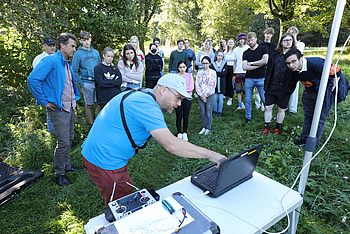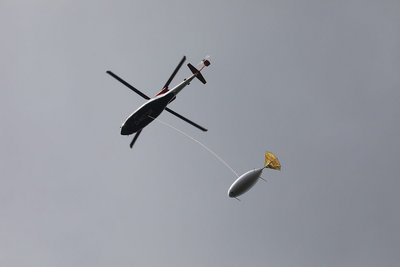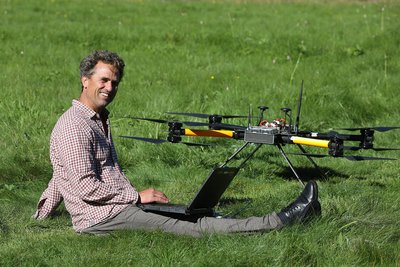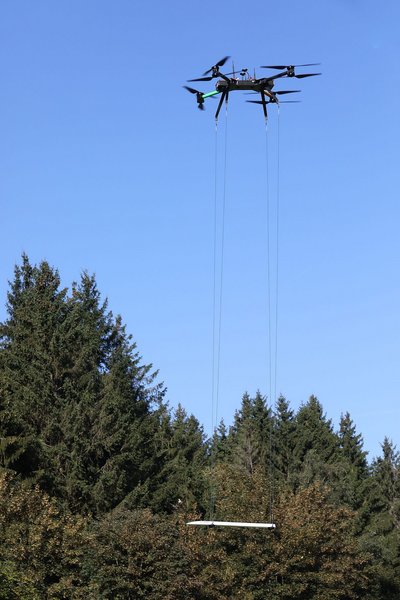Flight campaign to explore raw materials continues
From 18 to 23 September, helicopter flights for geophysical exploration will once again take place in the Upper Harz Mountains. Physics courses at the Robert Koch School have previously simulated the project with researchers.
The aim of the ‘Desmex-Real’ research project, which is planned to run until 2025 and is funded by the Federal Ministry of Education and Research, is to set up a so-called real laboratory in the Upper Harz mining region. According to project manager Prof. Michael Becken from the University of Münster, a semi-airborne electromagnetic method will be used to make statements about the electrical conductivity of geological structures. Dipole transmitters - earthed power cables on the ground - are combined with highly sensitive magnetic field sensors. The latter are located in flying probes and are towed by a helicopter on a cable at a height of 50 to 70 metres. The geophysicist explains that the measured data is used to create three-dimensional models of electrical conductivity, which can provide indications of raw materials in the ground. These are combined with knowledge from archive data from previous mining operations.
The flights, which take off from Hildesheim airfield, will cover several measurement areas outside the national park in the Clausthal-Zellerfeld, Altenau-Schulenberg, Riefensbeek and Oker and Bad Harzburg areas during this year's campaign. Helicopter flights were already carried out for this purpose in the Harz Mountains in 2021 and 2022. Project manager Becken explains that the low mountain range is a difficult flying area simply due to its topography and the many trees. In addition, there are many infrastructure-related interference signals, for example from railway tracks or underground cables. ‘Exploratory flights would be easier in the desert,’ says Prof Becken. ‘Desmex-Real’ is setting new standards: ‘This is a unique experiment that no one in the world has ever done before in this form.’ The scientist is referring in particular to the area-wide exploration.
The project manager vividly explained the importance of raw materials today to the 12th and 13th year physics courses at RKS: ‘Half the periodic table is built into a mobile phone.’ Due to electromobility and digital technologies alone, Europe is becoming increasingly dependent on raw material imports. The European Commission considers a number of important raw materials to be critical in terms of supply risk. Following a comment from a student, Becken added that recycling naturally plays a role. However, recycling alone would not be enough to cover the increasing global demand for raw materials.
Event at the secondary school initiated by the CUTEC research centre
The event at the secondary school was initiated and organised by Andre Bertram from the Clausthal Environmental Technology Research Centre (CUTEC) at Clausthal University of Technology. He acts as the contact person in the Upper Harz region for the numerous project partners involved under the aspect of ‘local networks’. In addition to the BGR, the University of Münster and Clausthal University of Technology, there are seven other institutions involved. To give the RKS pupils an impression of the exploratory flights, drone pilot Stefan Klingen (University of Münster) piloted a 14-kilogram drone equipped with a magnetic field sensor in the towed body over a meadow in the forest near the school. After analysing the data, the young people found out how many interference fields there were underground near the city. When the project leader placed a piece of iron on the meadow, this anomaly and its location were also clearly visible. The pupils enjoyed three exciting lessons in which they learnt about the latest geophysical measurement methods in theory and practice.
Contact:
TU Clausthal
Press, Communication and Marketing
Phone: +49 5323 72-3904
E-mail: presse@tu-clausthal.de
Physics classes at the Robert Koch School in Clausthal-Zellerfeld have been working on the "Desmex-Real" research project in class. The helicopter and drone flights (see pictures below) to explore raw materials in the Harz Mountains, which will take place again from September 18 to 23, were simulated by the young people using a miniature drone and scientific support. The initiative for this came from the CUTEC research center. Photos: André Bertram



